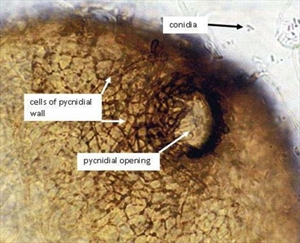Ascochyta spot.
Pacific Pests, Pathogens, Weeds & Pesticides - Online edition
Pacific Pests, Pathogens, Weeds & Pesticides
Bean (Ascochyta) leaf spot (319)
Boeremia exigua; previously known as Ascochyta phaseolorum, and Phoma exigua, and many other names. The name now given to the fungus is Boeremia exigua var. exigua.
The distribution of Boeremia exigua var. exigua is uncertain, and so far has only been recorded from Asia (China) and Oceania (Australia). Under different names e.g., Boeremia exigua or Phoma exigua (Ascochyta phaseolorum), it is recorded from Australia, Cook Islands, Fiji, New Zealand, Papua New Guinea, and Tonga.
On a wide range of plants in numerous plant families; it is particularly common on beans and other food legumes, e.g., cowpea and soybean, but is also recorded on capsicum (see Fact Sheet no. 239), citrus, and on weeds. In Solomon Islands, the fungus (as Phoma exigua) is reported as a large leaf spot on kauri (Agathis macrophylla).
A common fungus found in soils, causing a minor leaf spot disease on leaves and pods. Usually, either a wound pathogen following damage by insects and weather events, or a secondary invader of weakened or diseased plants. Sometimes infections start from rust pustules (see Fact Sheet no. 217). It is also found growing on dead plant material.
On the leaves, round, grey to brown spots, 6-12 mm wide, sometimes larger, with concentric rings (Photos 1-3). The spots have a brown margin. Sometimes, the centres of the spots dry and fall out ('shot-holes'). Tiny black fruiting bodies (pycnidia) occur in the leaf spots, and these can be seen with the naked eye (Photo 4). Inside the pycnidia there are masses of spores. Large, dark spots occur on the pods, usually starting from wounds (Photo 5).
Spread of the fungus occurs in wet weather which helps the discharge of spores. As the spores ooze out of the pycnidia through a hole at the top (Photo 3), they are splashed in rain (or irrigation water). There is a possibility that the spores of the fungus can be carried on seed. The fungus survives on dead plant material in the soil. High humidity and temperatures less than 28°C favour the disease.
The fungus is considered to be a weak parasite, or a wound pathogen, causing only a minor disease of bean; infection needs plants to be damaged by weather or by insects. It is probably similar to Capsicum Phoma blight and Phoma rot on tomato where it is usually only a problem in very wet seasons.
Look for spots on the leaves with concentric rings, brown, drying out with black fruiting bodies later. Look for spots where the centres have fallen out. Look for dark spots on the pods, often beginning from damaged areas. Best to have samples examined by a fungal taxonomist; there are diseases caused by other fungi which produce similar symptoms, and there are difficulties matching new and previous names of this fungus.
As the fungus is thought to be a wound pathogen, it is unlikely that control measures will be needed against this disease. If they are needed, do the following:
CULTURAL CONTROL
Before planting:
- Use certified seed, or treat seed in hot water hot water (50°C for 25-30 minutes).
- Weed and remove volunteers plants from previous crop or season.
During growth:
- Be careful not to damage plants during cultural operations.
- Avoid planting beans in places exposed to strong winds as plants are very susceptible to infection through wounds.
- Remove weeds which may be a source of the fungus.
After harvest:
- Handle fruit carefully during harvest and packing to avoid injury.
- As soon as the crop has been harvested remove or destroy the remains.
- Rotate crops so that crops of beans do not follow each other on the same land.
CHEMICAL CONTROL
This is not recommended as the fungus is thought be a wound pathogen. However, if insects are feeding on and wounding the pods, treat with e.g., pyrethrum, or a synthetic pyrethroid.
____________________
When using a pesticide, always wear protective clothing and follow the instructions on the product label, such as dosage, timing of application, and pre-harvest interval. Recommendations will vary with the crop and system of cultivation. Expert advice on the most appropriate pesticides to use should always be sought from local agricultural authorities.
AUTHORS Grahame Jackson & Eric McKenzie
Information from (including Photos 2&5) Diseases of vegetable crops in Australia (2010). Editors, Denis Persley, et al. CSIRO Publishing; and CABI (2016) Boeremia exigua var. exigua (leaf spot). Crop Protection Compendium. (https://www.cabi.org/cpc/datasheet/40426); and from (including Photo 4) McKenzie E (2013) Boeremia exigua: PaDIL - (http://www.padil.gov.au). Photo 1 R.J. Reynolds Tobacco Company Slide Set R.J. Reynolds Tobacco Company, Bugwood.org. Photo 3 Howard F. Schwartz Colorado State University, Bugwood.org.
Produced with support from the Australian Centre for International Agricultural Research under project PC/2010/090: Strengthening integrated crop management research in the Pacific Islands in support of sustainable intensification of high-value crop production, implemented by the University of Queensland and the Secretariat of the Pacific Community.








